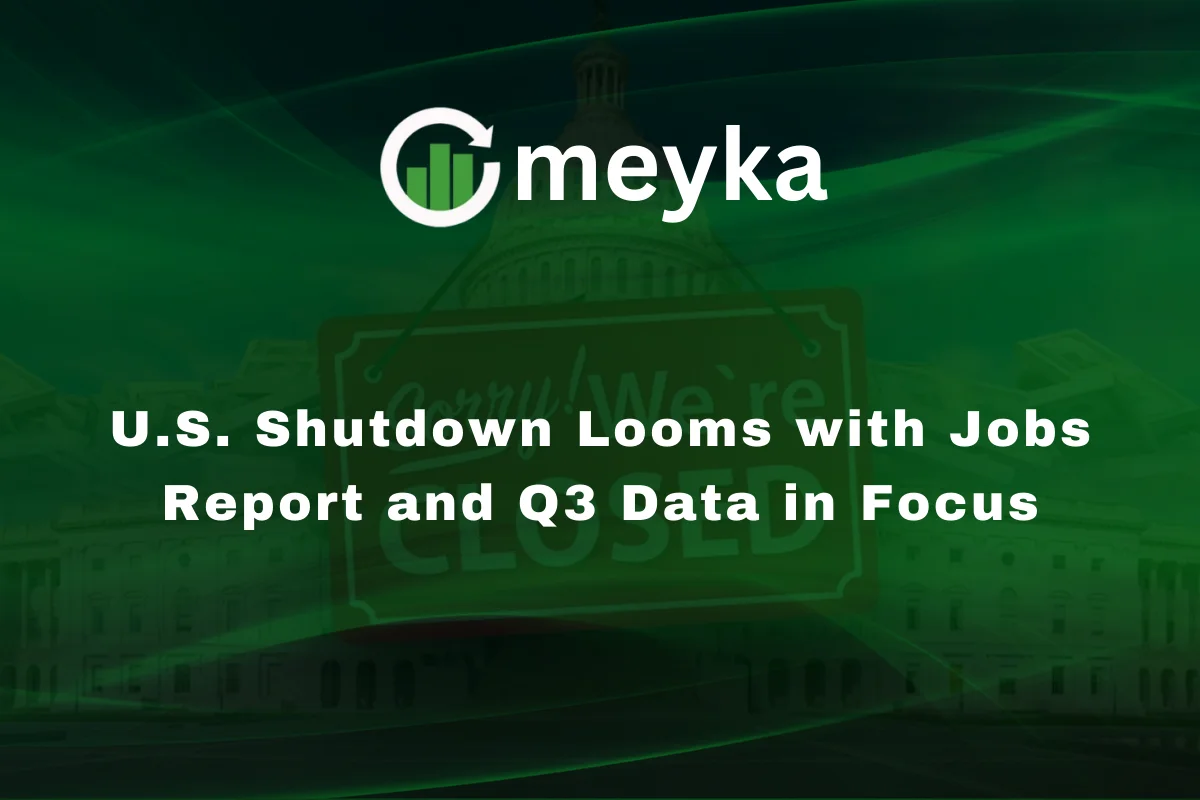U.S. Shutdown Looms with Jobs Report and Q3 Data in Focus
As the U.S. economy enters the final quarter of the year, the possibility of a government shutdown looms, sending ripples across the stock market, bond yields, and investor confidence. At the same time, critical data, including the September jobs report and Q3 GDP numbers, will play a decisive role in shaping expectations for the Federal Reserve’s next moves.
The combination of political uncertainty, tightening monetary policy, and economic crosswinds makes this one of the most pivotal weeks for Wall Street and global investors.
The Threat of a U.S. Shutdown and Its Economic Impact
The U.S. government faces another budget standoff as lawmakers remain divided over spending cuts and debt levels. If Congress fails to reach an agreement, non-essential services will halt, while millions of federal workers could face delayed paychecks.
A shutdown would not only impact everyday Americans but could also delay key economic reports that investors rely on for stock research and policymaking. Historically, markets have been volatile during shutdown periods, with sectors like defense, government contractors, and travel bearing the brunt.
However, not all industries react the same way. Defensive sectors such as healthcare and utilities often see inflows as investors seek safety. Tech and AI stocks may also maintain momentum as longer-term trends in automation and innovation outweigh near-term political noise.
Jobs Report: The Key to Fed Policy
The September jobs report, due this week, is expected to be a major market mover. Analysts anticipate a slowdown in job growth compared to earlier months, reflecting tighter financial conditions and waning consumer demand.
The Federal Reserve has repeatedly emphasized that the labor market remains a crucial factor in its inflation fight. A strong jobs report could strengthen the case for another rate hike, while weaker numbers may give the Fed room to pause.
For investors, the data will be critical in shaping sentiment. If wage growth cools, inflationary pressures could ease, giving breathing space to sectors sensitive to interest rates, such as real estate and growth stocks. On the other hand, persistent strength in hiring could renew concerns about sticky inflation.
Q3 GDP Data: Measuring Economic Resilience
The upcoming Q3 GDP report will offer a comprehensive view of how resilient the economy has been amid higher borrowing costs. Preliminary forecasts suggest moderate growth, but signs of weakness in consumer spending and housing are beginning to emerge.
Investors are watching closely to see whether the U.S. economy can achieve the elusive “soft landing.” A stronger-than-expected GDP reading could boost risk appetite, supporting cyclical stocks such as industrials and financials. Weak data, however, would increase fears of a recession, which has already been a major theme in stock market discussions throughout the year.
Stock Market Outlook Amid Looming Uncertainty
Wall Street has shown resilience in recent months, but risks remain elevated. The looming shutdown adds a new layer of unpredictability, while global pressures like oil price volatility and geopolitical tensions weigh heavily on sentiment.
- Technology and AI stocks remain attractive due to secular growth trends in automation, cloud computing, and digital transformation. Even in times of economic stress, these companies often continue to attract investor interest.
- Energy stocks have benefited from higher crude oil prices, though volatility could rise if global demand softens.
- Financials face a mixed outlook, with higher rates boosting net interest income but weighing on loan growth.
Market participants are increasingly focused on earnings season, where companies will provide fresh guidance that could either calm or intensify investor concerns.
Investor Strategies in a Volatile Environment
When uncertainty looms, disciplined strategies become essential. Investors are advised to diversify portfolios across asset classes, maintain liquidity, and focus on high-quality companies with strong balance sheets.
Defensive sectors such as healthcare, consumer staples, and utilities can offer stability. At the same time, selective exposure to growth areas like AI stocks provides opportunities for long-term gains.
Bond markets also deserve attention. Treasury yields have spiked to multi-year highs, creating both risks and opportunities for fixed-income investors. For those with a longer horizon, the current environment may present attractive entry points into bonds at higher yields.
Global Market Implications
The outcome of the U.S. political standoff will have global repercussions. A prolonged shutdown could undermine confidence in the U.S. government’s ability to manage its finances, impacting the dollar and global liquidity. Emerging markets, often reliant on dollar stability, could face heightened pressure.
Meanwhile, international investors continue to watch the Fed closely. Any shift in U.S. monetary policy directly influences global capital flows, commodity prices, and foreign exchange markets. The interconnected nature of today’s financial system means that what happens in Washington does not stay in Washington; it affects the entire world.
Conclusion
The coming weeks may prove decisive for the U.S. economy and the broader stock market. With a potential government shutdown looming, critical jobs and GDP data on the horizon, and a cautious Federal Reserve watching every number, investors face a period of heightened volatility.
Success in navigating this environment will depend on staying informed, disciplined, and prepared for multiple scenarios. The uncertainty is undeniable, but within it lies both risk and opportunity for those who manage portfolios with care.
FAQs
A shutdown often causes short-term volatility as investors worry about disruptions in government services and delayed economic data. However, the long-term impact is usually limited unless the shutdown is prolonged.
The Fed uses labor market data to gauge inflationary pressures. Strong job growth and rising wages can fuel inflation, pushing the Fed to raise rates. Weak data could allow for a more cautious approach.
Investors should diversify, maintain exposure to defensive sectors, and balance risk with growth opportunities such as AI stocks. Staying updated on economic data and Fed policy guidance is also essential.
Disclaimer:
This content is made for learning only. It is not meant to give financial advice. Always check the facts yourself. Financial decisions need detailed research.






